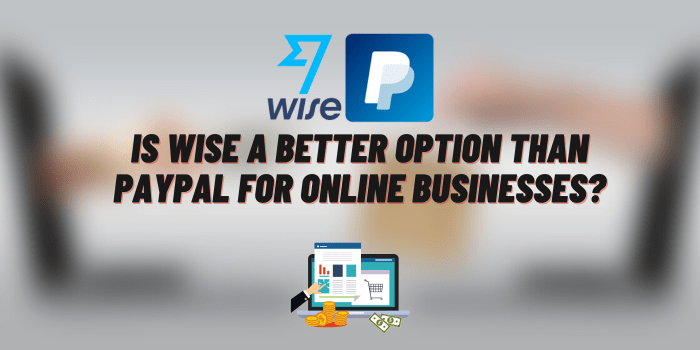Is Wise a Better Option Than PayPal for Online Businesses?
In the age of digital entrepreneurship, online financial transactions have become the backbone of every business. As the market evolves, different platforms offer varying benefits, features, and costs. PayPal has long been the go-to service for online payments, but a relatively new player, Wise (formerly TransferWise), has been gaining traction for its innovative approach to handling online transactions, especially for small businesses. This article will compare these two platforms and explore if Wise is indeed a better option than PayPal for online businesses.
Wise vs PayPal for Business Owners: Comparing the Most Important Aspects

When it comes to choosing between Wise and PayPal, several critical factors should be considered. These include fees, user experience, safety, options for withdrawing and funding, and paying invoices. Let’s dive into these factors one by one.
#1 Fees
Wise operates with a clear, upfront pricing policy, with fees typically based on a percentage of the transfer amount. They’re often lower than those of traditional banks and other transfer services, as Wise uses the real mid-market exchange rate without any markup.
On the other hand, PayPal charges a percentage of the transaction amount plus a fixed fee, and their currency conversion fees can be quite high. For international payments, PayPal’s charges can add up and impact your bottom line.
#2 User Experience
Wise has a simple, intuitive interface that makes it easy even for novices to send and receive money or manage their accounts. The platform also provides a multi-currency account, allowing businesses to hold and manage money in several currencies. In addition, a great user experience is essential for business apps.
PayPal also offers a user-friendly interface, and due to its widespread use, many users are already familiar with its operation. However, it does not offer as many options for multi-currency handling as Wise.
#3 Safety
Both Wise and PayPal prioritize user safety. Wise is regulated by the Financial Conduct Authority (FCA) in the UK, ensuring that it adheres to all necessary safety and regulatory standards. PayPal, a long-standing player in the online transaction field, is trusted worldwide and offers advanced encryption and fraud prevention measures.
#4 Withdrawing and Funding

For funding your account, Wise allows bank transfers, debit card, and credit card payments, while PayPal provides a similar range of options plus direct linking to your bank account for seamless transactions.
For withdrawals, both Wise and PayPal allow transferring funds back to your bank account. However, Wise tends to process withdrawals faster than PayPal.
#5 Paying Invoices
Wise simplifies invoice payments with their batch payment tool, allowing businesses to pay up to 1,000 invoices at once in multiple currencies, making it a useful tool for international businesses.
PayPal also offers invoice payment services but lacks batch payment capabilities. However, it does integrate with many e-commerce platforms, making it convenient for online retailers.
Wise Pros and Cons
Pros:
- Lower transaction fees;
- Real mid-market exchange rates;
- Multi-currency accounts;
- Batch invoice payment option;
- Faster withdrawals.
Cons:
- Not as widely recognized or accepted as PayPal;
- Not as many integrations with e-commerce platforms.
PayPal Pros and Cons

Pros:
- Widespread recognition and acceptance;
- User-friendly interface;
- Integrates with many e-commerce platforms;
- Robust security measures.
Cons:
- Higher transaction and currency conversion fees;
- Slower withdrawals;
- No batch invoice payment feature.
Wise vs PayPal Card
Another important factor that we need to consider is the card. Both Wise and PayPal offer their own branded cards with unique benefits and features. Let’s check them out below.
Wise Card
The Wise card is linked to your multi-currency account, allowing you to spend in different currencies at the real exchange rate. This feature is highly beneficial for businesses with international expenses, as it eradicates the need for currency exchange in most cases, thus saving on conversion fees. There’s no annual or monthly fee for the card, though certain services, like ATM withdrawals over a certain limit, may incur charges.
PayPal Card
PayPal offers both debit and credit cards. The PayPal Cashback Mastercard gives users 2% cash back on every purchase, and the PayPal Extras Mastercard allows users to earn points on everyday purchases. The PayPal Business Debit Mastercard offers 1% cash back on eligible purchases, and allows immediate access to your PayPal funds for purchases and ATM withdrawals. However, it’s worth noting that these cards might come with foreign transaction fees, which could add up for businesses dealing with international transactions.
In summary, if your business operates largely across borders, the Wise Card with its multi-currency capabilities and low fees might be the more advantageous option. However, if your operations are largely domestic and you’d benefit from cash-back rewards, the PayPal card options might be more appealing. As always, your specific business needs and transaction patterns should guide your decision.
Conclusion
In conclusion, both Wise and PayPal have their strengths and weaknesses. Wise’s lower fees, multi-currency accounts, and batch payment features make it an attractive option for international businesses. However, PayPal’s widespread acceptance and seamless integration with various platforms may make it a better fit for businesses primarily operating in e-commerce.
As always, the decision should be based on a business’s specific needs. Consider all factors, including the scale of international transactions, required integrations, and the importance of fee structures before deciding. Ultimately, whether Wise or PayPal is the better option for your online business depends on your individual business needs and operations.






